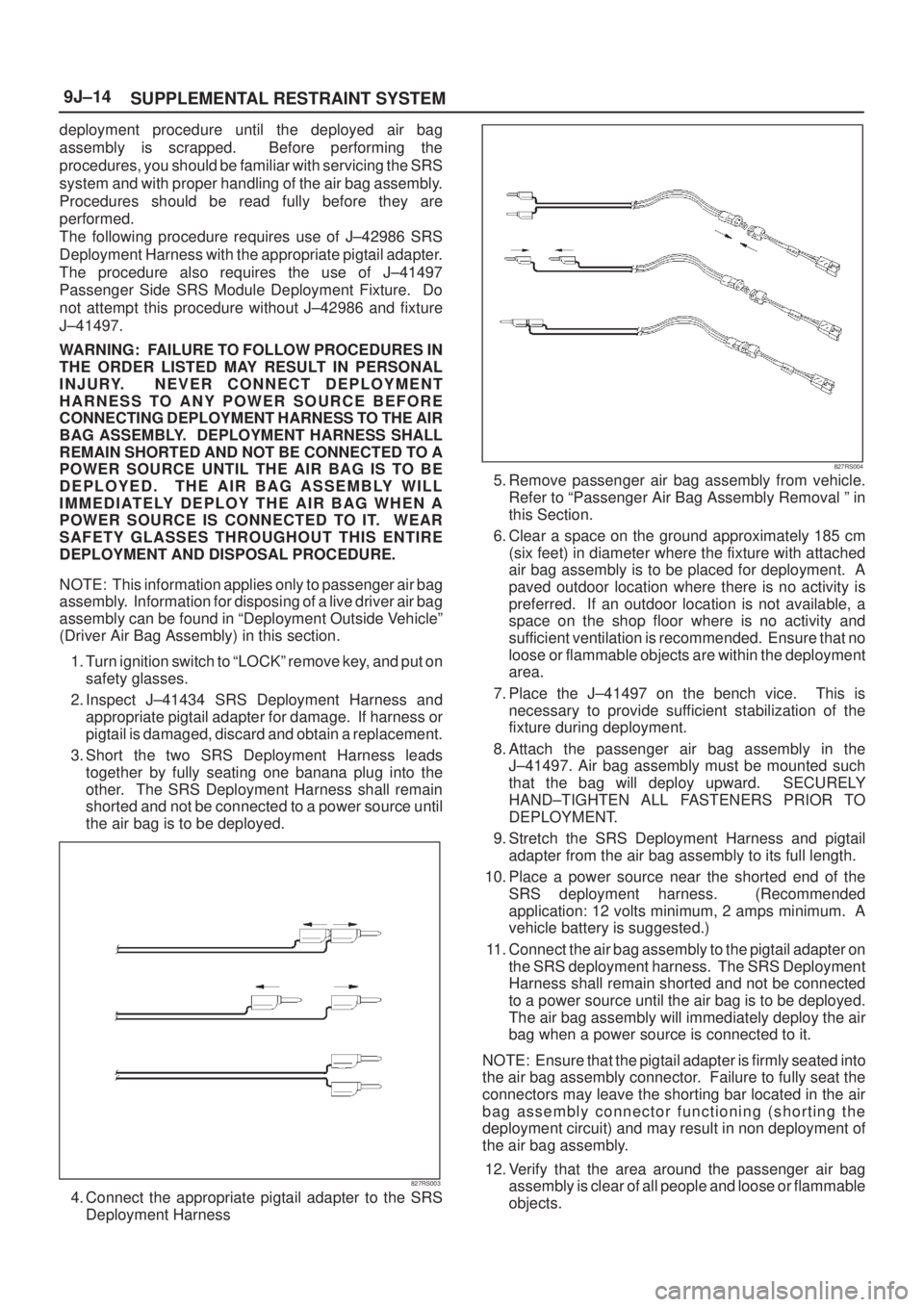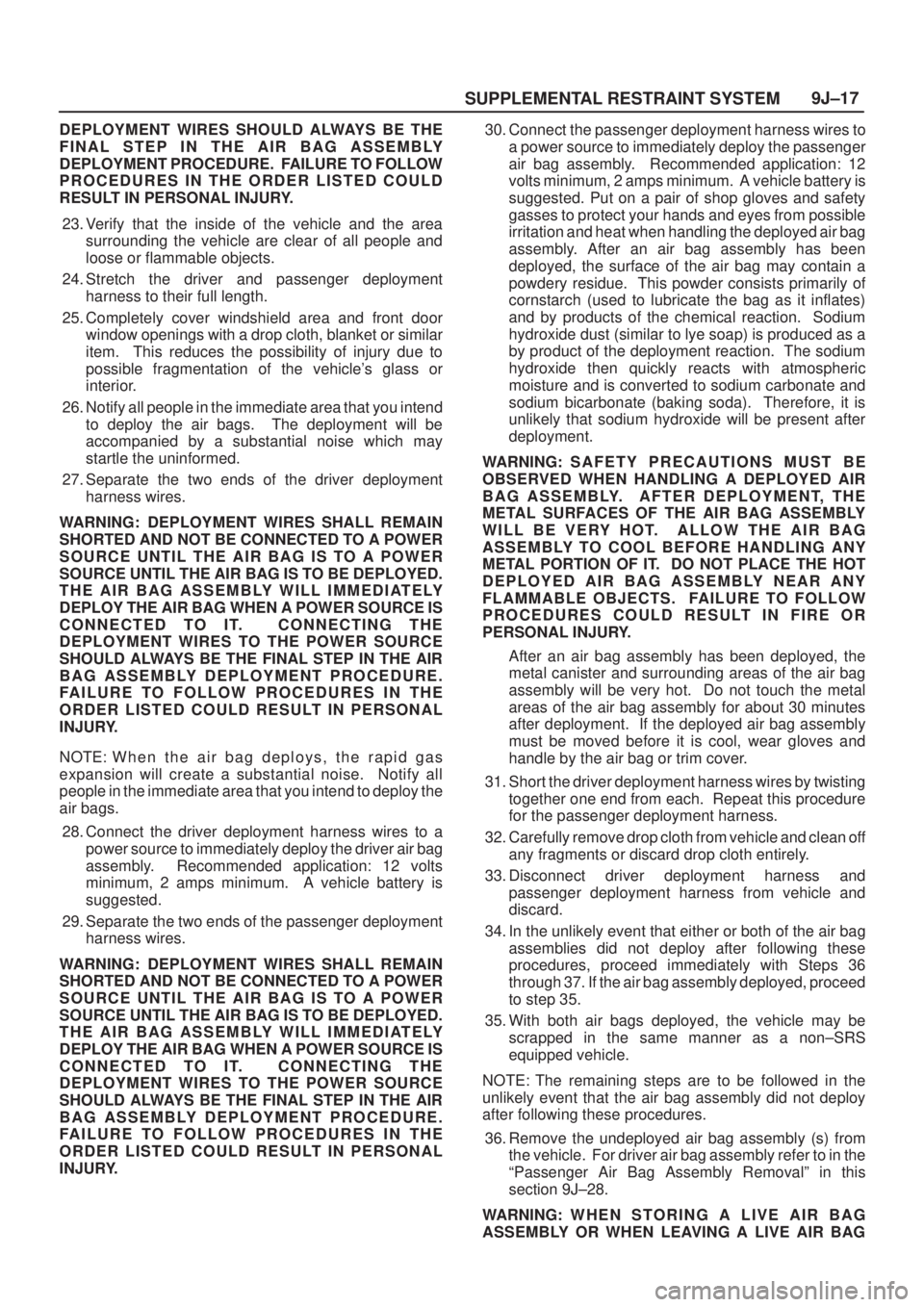2002 ISUZU AXIOM length
[x] Cancel search: lengthPage 2028 of 2100

SUPPLEMENTAL RESTRAINT SYSTEM 9J±14
deployment procedure until the deployed air bag
assembly is scrapped. Before performing the
procedures, you should be familiar with servicing the SRS
system and with proper handling of the air bag assembly.
Procedures should be read fully before they are
performed.
The following procedure requires use of J±42986 SRS
Deployment Harness with the appropriate pigtail adapter.
The procedure also requires the use of J±41497
Passenger Side SRS Module Deployment Fixture. Do
not attempt this procedure without J±42986 and fixture
J±41497.
WARNING: FAILURE TO FOLLOW PROCEDURES IN
THE ORDER LISTED MAY RESULT IN PERSONAL
INJURY. NEVER CONNECT DEPLOYMENT
HARNESS TO ANY POWER SOURCE BEFORE
CONNECTING DEPLOYMENT HARNESS TO THE AIR
BAG ASSEMBLY. DEPLOYMENT HARNESS SHALL
REMAIN SHORTED AND NOT BE CONNECTED TO A
POWER SOURCE UNTIL THE AIR BAG IS TO BE
DEPLOYED. THE AIR BAG ASSEMBLY WILL
IMMEDIATELY DEPLOY THE AIR BAG WHEN A
POWER SOURCE IS CONNECTED TO IT. WEAR
SAFETY GLASSES THROUGHOUT THIS ENTIRE
DEPLOYMENT AND DISPOSAL PROCEDURE.
NOTE: This information applies only to passenger air bag
assembly. Information for disposing of a live driver air bag
assembly can be found in ªDeployment Outside Vehicleº
(Driver Air Bag Assembly) in this section.
1. Turn ignition switch to ªLOCKº remove key, and put on
safety glasses.
2. Inspect J±41434 SRS Deployment Harness and
appropriate pigtail adapter for damage. If harness or
pigtail is damaged, discard and obtain a replacement.
3. Short the two SRS Deployment Harness leads
together by fully seating one banana plug into the
other. The SRS Deployment Harness shall remain
shorted and not be connected to a power source until
the air bag is to be deployed.
827RS003
4. Connect the appropriate pigtail adapter to the SRS
Deployment Harness
827RS004
5. Remove passenger air bag assembly from vehicle.
Refer to ªPassenger Air Bag Assembly Removal º in
this Section.
6. Clear a space on the ground approximately 185 cm
(six feet) in diameter where the fixture with attached
air bag assembly is to be placed for deployment. A
paved outdoor location where there is no activity is
preferred. If an outdoor location is not available, a
space on the shop floor where is no activity and
sufficient ventilation is recommended. Ensure that no
loose or flammable objects are within the deployment
area.
7. Place the J±41497 on the bench vice. This is
necessary to provide sufficient stabilization of the
fixture during deployment.
8. Attach the passenger air bag assembly in the
J±41497. Air bag assembly must be mounted such
that the bag will deploy upward. SECURELY
HAND±TIGHTEN ALL FASTENERS PRIOR TO
DEPLOYMENT.
9. Stretch the SRS Deployment Harness and pigtail
adapter from the air bag assembly to its full length.
10. Place a power source near the shorted end of the
SRS deployment harness. (Recommended
application: 12 volts minimum, 2 amps minimum. A
vehicle battery is suggested.)
11. Connect the air bag assembly to the pigtail adapter on
the SRS deployment harness. The SRS Deployment
Harness shall remain shorted and not be connected
to a power source until the air bag is to be deployed.
The air bag assembly will immediately deploy the air
bag when a power source is connected to it.
NOTE: Ensure that the pigtail adapter is firmly seated into
the air bag assembly connector. Failure to fully seat the
connectors may leave the shorting bar located in the air
bag assembly connector functioning (shorting the
deployment circuit) and may result in non deployment of
the air bag assembly.
12. Verify that the area around the passenger air bag
assembly is clear of all people and loose or flammable
objects.
Page 2031 of 2100

SUPPLEMENTAL RESTRAINT SYSTEM9J±17
DEPLOYMENT WIRES SHOULD ALWAYS BE THE
FINAL STEP IN THE AIR BAG ASSEMBLY
DEPLOYMENT PROCEDURE. FAILURE TO FOLLOW
PROCEDURES IN THE ORDER LISTED COULD
RESULT IN PERSONAL INJURY.
23. Verify that the inside of the vehicle and the area
surrounding the vehicle are clear of all people and
loose or flammable objects.
24. Stretch the driver and passenger deployment
harness to their full length.
25. Completely cover windshield area and front door
window openings with a drop cloth, blanket or similar
item. This reduces the possibility of injury due to
possible fragmentation of the vehicle's glass or
interior.
26. Notify all people in the immediate area that you intend
to deploy the air bags. The deployment will be
accompanied by a substantial noise which may
startle the uninformed.
27. Separate the two ends of the driver deployment
harness wires.
WARNING: DEPLOYMENT WIRES SHALL REMAIN
SHORTED AND NOT BE CONNECTED TO A POWER
SOURCE UNTIL THE AIR BAG IS TO A POWER
SOURCE UNTIL THE AIR BAG IS TO BE DEPLOYED.
THE AIR BAG ASSEMBLY WILL IMMEDIATELY
DEPLOY THE AIR BAG WHEN A POWER SOURCE IS
CONNECTED TO IT. CONNECTING THE
DEPLOYMENT WIRES TO THE POWER SOURCE
SHOULD ALWAYS BE THE FINAL STEP IN THE AIR
BAG ASSEMBLY DEPLOYMENT PROCEDURE.
FAILURE TO FOLLOW PROCEDURES IN THE
ORDER LISTED COULD RESULT IN PERSONAL
INJURY.
NOTE: W h e n t h e a i r b a g deploys, the rapid gas
expansion will create a substantial noise. Notify all
people in the immediate area that you intend to deploy the
air bags.
28. Connect the driver deployment harness wires to a
power source to immediately deploy the driver air bag
assembly. Recommended application: 12 volts
minimum, 2 amps minimum. A vehicle battery is
suggested.
29. Separate the two ends of the passenger deployment
harness wires.
WARNING: DEPLOYMENT WIRES SHALL REMAIN
SHORTED AND NOT BE CONNECTED TO A POWER
SOURCE UNTIL THE AIR BAG IS TO A POWER
SOURCE UNTIL THE AIR BAG IS TO BE DEPLOYED.
THE AIR BAG ASSEMBLY WILL IMMEDIATELY
DEPLOY THE AIR BAG WHEN A POWER SOURCE IS
CONNECTED TO IT. CONNECTING THE
DEPLOYMENT WIRES TO THE POWER SOURCE
SHOULD ALWAYS BE THE FINAL STEP IN THE AIR
BAG ASSEMBLY DEPLOYMENT PROCEDURE.
FAILURE TO FOLLOW PROCEDURES IN THE
ORDER LISTED COULD RESULT IN PERSONAL
INJURY.30. Connect the passenger deployment harness wires to
a power source to immediately deploy the passenger
air bag assembly. Recommended application: 12
volts minimum, 2 amps minimum. A vehicle battery is
suggested. Put on a pair of shop gloves and safety
gasses to protect your hands and eyes from possible
irritation and heat when handling the deployed air bag
assembly. After an air bag assembly has been
deployed, the surface of the air bag may contain a
powdery residue. This powder consists primarily of
cornstarch (used to lubricate the bag as it inflates)
and by products of the chemical reaction. Sodium
hydroxide dust (similar to lye soap) is produced as a
by product of the deployment reaction. The sodium
hydroxide then quickly reacts with atmospheric
moisture and is converted to sodium carbonate and
sodium bicarbonate (baking soda). Therefore, it is
unlikely that sodium hydroxide will be present after
deployment.
WARNING: S A F E T Y P R ECAUTIONS MUST BE
OBSERVED WHEN HANDLING A DEPLOYED AIR
BAG ASSEMBLY. AFTER DEPLOYMENT, THE
METAL SURFACES OF THE AIR BAG ASSEMBLY
WILL BE VERY HOT. ALLOW THE AIR BAG
ASSEMBLY TO COOL BEFORE HANDLING ANY
METAL PORTION OF IT. DO NOT PLACE THE HOT
DEPLOYED AIR BAG ASSEMBLY NEAR ANY
FLAMMABLE OBJECTS. FAILURE TO FOLLOW
PROCEDURES COULD RESULT IN FIRE OR
PERSONAL INJURY.
After an air bag assembly has been deployed, the
metal canister and surrounding areas of the air bag
assembly will be very hot. Do not touch the metal
areas of the air bag assembly for about 30 minutes
after deployment. If the deployed air bag assembly
must be moved before it is cool, wear gloves and
handle by the air bag or trim cover.
31. Short the driver deployment harness wires by twisting
together one end from each. Repeat this procedure
for the passenger deployment harness.
32. Carefully remove drop cloth from vehicle and clean off
any fragments or discard drop cloth entirely.
33. Disconnect driver deployment harness and
passenger deployment harness from vehicle and
discard.
34. In the unlikely event that either or both of the air bag
assemblies did not deploy after following these
procedures, proceed immediately with Steps 36
through 37. If the air bag assembly deployed, proceed
to step 35.
35. With both air bags deployed, the vehicle may be
scrapped in the same manner as a non±SRS
equipped vehicle.
NOTE: The remaining steps are to be followed in the
unlikely event that the air bag assembly did not deploy
after following these procedures.
36. Remove the undeployed air bag assembly (s) from
the vehicle. For driver air bag assembly refer to in the
ªPassenger Air Bag Assembly Removalº in this
section 9J±28.
WARNING: W H E N S T O R I N G A L I V E A I R B A G
ASSEMBLY OR WHEN LEAVING A LIVE AIR BAG